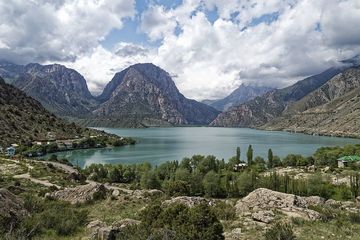Results for "food"
63 Results
Science and Technology Scholar
The four-part framework (investigating the issue, recognizing perspectives, communicating ideas, taking action) incorporated into this micro-credential reflects the changing role of our students in the 21st century. Students must have a substantive understanding of the complex, diverse, and interdependent world in which they live. Educators will delve into the research that supports the students becoming globally competent through inquiry. The four-part framework is described below. Additional resources are available in the “Supporting Rationale and Research” section and should be examined prior to completing this micro-credential.
Read more

By: Scarlet Patrick
Due Date: Jun, 24, 2021
Agri-food systems
+2
Leave a comment

Agri and food Scholar
The four-part framework (investigating the issue, recognizing perspectives, communicating ideas, taking action) incorporated into this micro-credential reflects the changing role of our students in the 21st century. Students must have a substantive understanding of the complex, diverse, and interdependent world in which they live. Educators will delve into the research that supports the students becoming globally competent through inquiry. The four-part framework is described below. Additional resources are available in the “Supporting Rationale and Research” section and should be examined prior to completing this micro-credential.
Read more

By: Scarlet Patrick
Due Date: May, 21, 2021
Agri-food systems
+1
Leave a comment

Agri and food Scholar
Global Competence Framework
The four-part framework (investigating the issue, recognizing perspectives, communicating ideas, taking action) incorporated into this micro-credential reflects the changing role of our students in the 21st century. Students must have a substantive understanding of the complex, diverse, and interdependent world in which they live. Educators will delve into the research that supports the students becoming globally competent through inquiry. The four-part framework is described below. Additional resources are available in the “Supporting Rationale and Research” section and should be examined prior to completing this micro-credential.
Investigate the worldStudents must engage in activities and explorations where they are able to investigate their world beyond their immediate environment. Research that is age-appropriate should be conducted where problems are framed that are significant at the local, regional, or global level.
Recognize perspectivesStudents must engage in activities where they are asked to recognize and express their own perspectives on situations, events, issues, or phenomena. Additionally, students should examine the perspectives of others and determine how that perspective has developed or changed based on exposure to different periods and cultures.
Communicate ideasStudents must engage in activities where they are able to listen to and communicate effectively with diverse people. Additionally, it is important to be able to recognize and express how diverse people perceive meaning and how this is affected by communication.
Take actionStudents must take action to address situations, events, and issues to improve conditions. Additionally, it is important to identify and create opportunities for personal and collaborative actions aimed at improving conditions locally, regionally, or globally.
Read more

By: Scarlet Patrick
Due Date: Apr, 23, 2021
Water, energy, and the...
Leave a comment

Agri and food Scholar
The four-part framework (investigating the issue, recognizing perspectives, communicating ideas, taking action) incorporated into this micro-credential reflects the changing role of our students in the 21st century. Students must have a substantive understanding of the complex, diverse, and interdependent world in which they live. Educators will delve into the research that supports the students becoming globally competent through inquiry. The four-part framework is described below. Additional resources are available in the “Supporting Rationale and Research” section and should be examined prior to completing this micro-credential.
Investigate the worldStudents must engage in activities and explorations where they are able to investigate their world beyond their immediate environment. Research that is age-appropriate should be conducted where problems are framed that are significant at the local, regional, or global level.
Read more

By: Jenny Reze Scarlet
Due Date: May, 8, 2021
Health and nutrition
+1
Leave a comment
Food Tech Scholar
Types of accommodations
Accommodations are typically divided into four categories:
Presentation accommodations
Response accommodations
Setting accommodations
Timing and scheduling accommodations
How can educators identify and select accommodations to address the needs of individual students?
Using a set of guiding questions, the teacher will identify one response accommodation for a student with a disability based on his or her individual strengths and needs and the barrier created by the disability. The educator will then implement the accommodation and evaluate its effectiveness. Finally, the teacher and student will reflect on the effectiveness of the accommodation.
Read more

By: Lorell Sandi
Due Date: Feb, 26, 2021
Culture and society
+2
Leave a comment

Agri and food Scholar
Supporting Rationale and Research
Bannan-Ritland, B. (2002). Computer-mediated communication, elearning, and interactivity: A review of the research. Quarterly Review of Distance Education, 3(2), 161-79.
Dwyer, K. K., Bingham, S. G., Carlson, R. E., Prisbell, M., Cruz, A. M., & Fus, D. A. (2004). Communication and connectedness in the classroom: Development of the connected classroom climate inventory. Communication Research Reports, 21(3), 264-272.http://bit.ly/2s8jFEH
Wiemann, J. M., & Backlund, P. (1980). Current theory and research in communicative competence. Review of how does it achieve its effects? American Educational Research Journal, 50(1), 185-199.http://journals.sagepub.com/doi/abs/10.3102/00346543050001185
Greene, J. A., Seung, B. Y., & Copeland, D. Z. (2014). Measuring critical components of digital literacy and their relationships with learning. Computers & Education, 76, 55-69.
Read more

By: Rose Hozw
Due Date: Apr, 24, 2021
Health and nutrition
+1
Leave a comment

Data leakage detection system
The primary task of data leakage detection systems is to detect data leakage and discover the sources for the same. If ever an organization’s sensitive data gets leaked, it may then finds its way to unauthorized devices. This is why it is crucial to trace the source of data leakage so that you can nip the problem in the bud.
Read more

By: Edwin Castel
Due Date: Oct, 28, 2020
Agri-food systems
+1
Leave a comment

Where they are living
Avoid asking exactly where they live. You don’t need to know their address. Just keep it to general areas.
What part of (city you are in) do you live in?
How do you like your neighborhood?
When did you move there?
What’s the best thing about living in that part of town?
Read more

By: Edwin Castel
Due Date: Sep, 16, 2020
Agri-food systems
+2
Leave a comment

Quality traits in aquaculture
Quality traits in aquaculture
Aquaculture species are reared for particular traits such as growth rate, survival rate, meat quality, resistance to diseases, age at sexual maturation, fecundity, shell traits like shell size, shell colour, etc.
Growth rate – growth rate is normally measured as either body weight or body length. This trait is of great economic importance for all aquaculture species as faster growth rate speeds up the turnover of production.[19] Improved growth rates show that farmed animals utilize their feed more efficiently through a positive correlated response.[18]
Survival rate – survival rate may take into account the degrees of resistance to diseases.[18] This may also see the stress response as fish under stress are highly vulnerable to diseases.[19] The stress fish experience could be of biological, chemical or environmental influence.
Meat quality – the quality of fish is of great economic importance in the market. Fish quality usually takes into account size, meatiness, and percentage of fat, colour of flesh, taste, shape of the body, ideal oil and omega-3 content.[18][
Read more

By: Ameliya
Due Date: Oct, 18, 2020
Agri-food systems
+4
Leave a comment

Plant breeding
Plant breeding
Plant breeding has been used for thousands of years, and began with the domestication of wild plants into uniform and predictable agricultural cultigens. High-yielding varieties have been particularly important in agriculture.
Selective plant breeding is also used in research to produce transgenic animals that breed "true" (i.e., are homozygous) for artificially inserted or deleted genes.[1
Read more

By: Ameliya
Due Date: Oct, 31, 2020
Agri-food systems
+5
Leave a comment

Agri and food Scholar
Selective breeding (also called artificial selection) is the process by which humans use animal breeding and plant breeding to selectively develop particular phenotypic traits (characteristics) by choosing which typically animal or plant males and females will sexually reproduce and have offspring together. Domesticated animals are known as breeds, normally bred by a professional breeder, while domesticated plants are known as varieties, cultigens, cultivars, or breeds.[1] Two purebred animals of different breeds produce a crossbreed, and crossbred plants are called hybrids. Flowers, vegetables and fruit-trees may be bred by amateurs and commercial or non-commercial professionals: major crops are usually the provenance of the professionals.
Read more

By: Ameliya
Due Date: Oct, 23, 2020
Health and nutrition
+2
Leave a comment
venture capital :
A new permanently positively charged stable isotope labeling (SIL) agent pair, 4-(((2,5-dioxopyrrolidin-1-yl)oxy)carbonyl)-N,N,N-trimethylbenzenaminium iodide(DPTBA) and its deuterated counterpart d3-DPTBA,
Read more

By: Ameliya
Due Date: Sep, 30, 2020
Agri-food systems
+6

Leave a comment